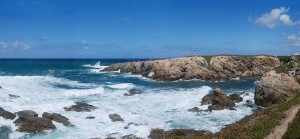We have much more to do and your continued support is needed now more than ever.
We Must Care for the Oceans
 Six decades ago, Rachel Carson wrote about the “bewildering abundance” of life found in the surface waters of the seas. While conducting her studies, she discovered that some fish migratory patterns were changing. She was the first scientist to suggest that temperature changes in ocean currents were altering those patterns, and she alerted us that the oceans were responding to a warming world in The Sea Around Us.
Six decades ago, Rachel Carson wrote about the “bewildering abundance” of life found in the surface waters of the seas. While conducting her studies, she discovered that some fish migratory patterns were changing. She was the first scientist to suggest that temperature changes in ocean currents were altering those patterns, and she alerted us that the oceans were responding to a warming world in The Sea Around Us.
Today, we know that Rachel’s observations about “the global thermostat” were prescient. Recent studies confirm that the oceans have indeed warmed by about 1 degree F to a depth of 200 feet, and the overwhelming scientific consensus is that increasing levels of human-caused greenhouse gases in the atmosphere are the principal cause of this profound change in marine temperatures.
Since higher surface-water temperatures amplify hurricane intensities, the implications of warming seas should not be ignored. As ocean temperatures continue to increase, hurricanes are expected to have stronger winds and produce more rainfall—unwelcome news for coastal areas already experiencing storm-related losses.
Warmer ocean currents also can introduce migrating fish and invasive species to areas they previously didn’t inhabit, and the new arrivals can overwhelm native populations or alter newfound aquatic habitats. Warm waters tend to amplify the threats of pollution and exacerbate overfishing on weakened marine systems. Overheated, these systems have less ability to hold oxygen, threatening near-shore habitats that carry high pollution loads. Degraded estuaries, tidal flats, bays and other nursery waters are at particular risk. These fragile habitats can become oxygen-deprived faster in a warming world. Oxygen depletion is not limited to coastal habitats, however. It is a growing menace to vast oceanic regions.
As water temperatures rise, the ocean’s most productive and sensitive ecosystems are showing the strain. On reefs, the algae living symbiotically within coral die, leaving the telltale ghostly bleached coral skeletons. Lacking algae for prolonged periods, the coral can suffer irreversible decline and, ultimately, death. Loss of coral has enormous implications for fish and the rest of the marine web of life, as well as coastal communities.
Researchers have documented that warming ocean currents have accelerated melting of the floating Arctic sea ice sheet and the decline and breakup of Antarctic ice shelves. Greenland is now losing an estimated 100 billion tons of ice annually as a result of this accelerated melting. And sea levels are now projected to rise much faster than predicted by the Intergovernmental Panel on Climate Change in 2007 as a result of this acceleration, further threatening coastal habitats and human infrastructures.
Warming is not the only threat to our seas. Oceans collectively absorb about 25 percent of the annual carbon dioxide emissions from human activities, and they are becoming more acidic as carbonic acid accumulates. This has caused seawater to become more corrosive to shells and marine organism skeletons, and is interfering with production of phytoplankton.
A recently published study revealed that phytoplankton has declined by about 40 percent in the past 60 years. Another study suggests that increasing acidity reduces the availability of iron, an element crucial to phytoplankton production. Because iron already is limited in marine waters, increased acidity may have grave implications.
This is extremely important to everyone, even those of us who don’t visit beaches, scuba dive or go deep-sea fishing. Phytoplankton are responsible for more than 50 percent of the oxygen-producing photosynthesis on the planet. They also are vital building blocks in the oceanic web of life.
I wish I were making this stuff up. Sadly, the facts about these threats are well-documented in scientific literature. The simple truth is this: If we continue to pollute the air with carbon dioxide, the more acidic oceans will block iron needed for phytoplankton and become more corrosive to the shells of marine organisms. This will surely threaten the entire marine food web.
While more research can help us better understand the full range of consequences of human-induced acidification, carbon pollution clearly is acidifying the oceans, as well as heating our atmosphere. Leading climate scientist Robert Corell has determined that even with carbon reductions planned by 194 nations, average global temperature is expected to rise by 4 degrees F by 2050 and acidification of our oceans would continue.
What can each of us do to help reverse this crisis? Tell the president and Congress—and everyone who aspires to those elected offices—we need a science-based energy policy that ends carbon emissions. To learn more about NWF’s efforts to protect and restore coastal areas and combat warming, visit www. nwf.org/globalwarming and http://www.nwf.org/Oil-Spill/On-the-Ground.aspx.





















